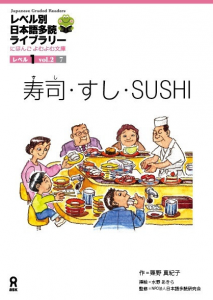 Interpretive reading is a new ‘push’ of mine and I’ve been making full use of my supply of graded readers for this. My Yr4’s are currently working in a food unit and I tapped the “Sushi” reading for this purpose. It is from a lower level than my students can handle but perfect for this read/use activity.(Just a note that due to extensive kanji (Chinese character) use in ‘real’ authentic resources, and a class composed of 50% character readers, I’ve been using the ‘created by Japanese/adapted by Japanese for language-learners’ stories).
Interpretive reading is a new ‘push’ of mine and I’ve been making full use of my supply of graded readers for this. My Yr4’s are currently working in a food unit and I tapped the “Sushi” reading for this purpose. It is from a lower level than my students can handle but perfect for this read/use activity.(Just a note that due to extensive kanji (Chinese character) use in ‘real’ authentic resources, and a class composed of 50% character readers, I’ve been using the ‘created by Japanese/adapted by Japanese for language-learners’ stories).
Day 1 – the pair ‘Interpretive Reading/Question-Making Activity’: I designed a series of questions designed to tap their prior knowledge (and in our area of the world it is extensive) about sushi. They worked in partners for this – with a mind to the ensuing activity. The rule in the reading activity is, of course, no dictionaries but rather using picture and word clues to find the information. They tackled this quite easily but it did require careful reading. I noted partners correcting each other’s answers/ideas and pointing to parts of the text to make their point. Well done! We did not go over the answers in class as I checked in with each group and prompted changes when needed. Everyone had the information they needed to proceed to next part of the activity.
Now on to the key part of the interpretive reading – the ‘Challenge Quiz’ questions! Students were asked to come up with 10 questions/answers (in a variety of formats – multiple choice, true/false, fill in the blank) about the sections read, in the Japanese. From the assignment: You will challenge other teams – but you will ‘read’ your questions so they should not be long/complicated. Answers must be ‘easily’ found in the text and not based on the ‘fine print’ or knowledge of kanji. Your questions must not require dictionaries to understand – they are to be understood by your classmates. Students worked hard on their questions (in fact I dropped the requirement to 8 due to time constraints) and came to class ready for Day 2.
Day 2 – the ‘Interpersonal’ Pair Challenge – I gave the students some time to review their questions as well as become familiar with the phrases for question types (how do you say “this is a multiple choice question” in your target language?). I also introduced them to the points system they would be using. Essentially a team got a 1-point for answering correctly without using the text, 1/2-point for having to find the answer in the text and 2 points if the answer the questioning team gave was wrong! We also reviewed potentially useful language like ‘guessing’ (“I’m pretty sure the answer is…”) and ‘you’re right/wrong’. Then they paired up opposite another team and began. There was lots of intent listening and laughing (as well as a few well placed insults). They spent about 35minutes in the TL asking/answering and many were upset they didn’t get more questioning time.
Student Feedback/What I Will Do For Next Time – I asked my students for feedback on this activity specifically on how they liked it/didn’t like it, what they needed that they didn’t have to do it and if we should do it again. They loved the activity for the ‘spontaneity’ it required in asking. For next time I will include ‘debrief’ time as many students wanted to hear ‘the most interesting questions’ that teams asked. Students asked for ‘arguing’ phrases (and mild ‘joking’ ones) to use against their partners. I only used parts of the reading for this activity and many wrote that they wanted to read the whole thing (yeah!)
I like the idea of this kind of ‘mash-up’ and the noise, laughter and ‘arguing’ in the room tells me that it was an effective way to encourage speaking/listening. More please!
Colleen

